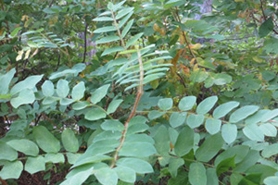BRISTLY LOCUST OR ROSE ACACIA
(Robinia hispida)
Perennial shrub in the pea family with rose-colored flowers and red bristly stalks.
Other names for this plant include:
- Scientific names: R. hispida var. fertilis, R. hispida var. hispida, R. grandiflora
Classification in Wisconsin: Restricted
- Ecological Threat
-
- Invades numerous habitat types: upland forests, forest edges, prairies, forested dunes, grasslands, roadsides, and disturbed vacant areas.
- Previously planted as fence rows, escaping cultivation.
- Tolerant of many soils but most readily colonizes light-textured soils with good drainage, preferring sandy and silt loams.
- Nitrogen-fixing microbial symbionts alter soil chemistry.
- Expands create dense thickets.
- Seeds remain viable in the soil for 1-10 years.
- Multiple sterile and nonsterile varieties exist, with both types naturalizing.
- Identification
-
Leaves & stems: Alternate, pinnately compound leaves. Small round leaflets are bright green and paler on the underside. Stems covered in thick red bristles. The bark is grey-brown and covered in raised lenticels.
Flowers, fruits & seeds: Rose-colored pea flowers. Seed pods are brown and flat, covered in dense reddish bristles.
Roots: Spreads by root suckering.
- Control
- Mechanical:
- Pull small plants, and use a weed wrench on larger shrubs.
- Remove all roots if possible, and monitor for resprouts.
- Use cut stump or basal bark herbicide techniques with glyphosate or triclopyr in the fall.
- Monitor for resprouts.
- Resources
- Sources for content:
- University of Wisconsin - Stevens Point; Robert W. Freckmann Herbarium.
- Virginia Tech Department of Forest Resources and Environmental Conservation.



